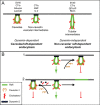Regulation of raft-dependent endocytosis
- PMID: 17760830
- PMCID: PMC3823247
- DOI: 10.1111/j.1582-4934.2007.00083.x
Regulation of raft-dependent endocytosis
Abstract
Raft-dependent endocytosis is in large part defined as the cholesterol-sensitive, clathrin-independent internalization of ligands and receptors from the plasma membrane. It encompasses the endocytosis of caveolae, smooth plasmalemmal vesicles that form a subdomain of cholesterol and sphingolipid-rich lipid rafts and that are enriched for caveolin-1. While sharing common mechanisms, like cholesterol sensitivity, raft endocytic routes show differential regulation by various cellular components including caveolin-1, dynamin-2 and regulators of the actin cytoskeleton. Dynamin-dependent raft pathways, mediated by caveolae and morphologically equivalent non-caveolin vesicular intermediates, are referred to as caveolae/raft-dependent endocytosis. In contrast, dynamin-independent raft pathways are mediated by non-caveolar intermediates. Raft-dependent endocytosis is regulated by tyrosine kinase inhibitors and, through the regulation of the internalization of various ligands, receptors and effectors, is also a determinant of cellular signaling. In this review, we characterize and discuss the regulation of raft-dependent endocytic pathways and the role of key regulators such as caveolin-1.
Figures

Similar articles
-
Lipid rafts, caveolae, and their endocytosis.Int Rev Cell Mol Biol. 2010;282:135-63. doi: 10.1016/S1937-6448(10)82003-9. Epub 2010 Jun 18. Int Rev Cell Mol Biol. 2010. PMID: 20630468 Review.
-
Caveolae/raft-dependent endocytosis.J Cell Biol. 2003 May 26;161(4):673-7. doi: 10.1083/jcb.200302028. J Cell Biol. 2003. PMID: 12771123 Free PMC article. Review.
-
Caveosomes and endocytosis of lipid rafts.J Cell Sci. 2003 Dec 1;116(Pt 23):4707-14. doi: 10.1242/jcs.00840. J Cell Sci. 2003. PMID: 14600257 Review.
-
Caveolin-1 regulation of dynamin-dependent, raft-mediated endocytosis of cholera toxin-B sub-unit occurs independently of caveolae.J Cell Mol Med. 2009 Sep;13(9B):3218-25. doi: 10.1111/j.1582-4934.2009.00732.x. Epub 2009 Mar 6. J Cell Mol Med. 2009. PMID: 19438805 Free PMC article.
-
Avian Reovirus σB Interacts with Caveolin-1 in Lipid Rafts during Dynamin-Dependent Caveolae-Mediated Endocytosis.Viruses. 2022 Oct 6;14(10):2201. doi: 10.3390/v14102201. Viruses. 2022. PMID: 36298756 Free PMC article.
Cited by
-
LRP-1--CD44, a new cell surface complex regulating tumor cell adhesion.Mol Cell Biol. 2012 Aug;32(16):3293-307. doi: 10.1128/MCB.00228-12. Epub 2012 Jun 18. Mol Cell Biol. 2012. PMID: 22711991 Free PMC article.
-
CLN7/MFSD8 may be an important factor for SARS-CoV-2 cell entry.iScience. 2022 Oct 21;25(10):105082. doi: 10.1016/j.isci.2022.105082. Epub 2022 Sep 6. iScience. 2022. PMID: 36093380 Free PMC article.
-
Altered endocytosis in cellular senescence.Ageing Res Rev. 2021 Jul;68:101332. doi: 10.1016/j.arr.2021.101332. Epub 2021 Mar 19. Ageing Res Rev. 2021. PMID: 33753287 Free PMC article. Review.
-
Leishmania-induced inactivation of the macrophage transcription factor AP-1 is mediated by the parasite metalloprotease GP63.PLoS Pathog. 2010 Oct 14;6(10):e1001148. doi: 10.1371/journal.ppat.1001148. PLoS Pathog. 2010. PMID: 20976196 Free PMC article.
-
Directing traffic in neural cells: determinants of receptor tyrosine kinase localization and cellular responses.J Neurochem. 2008 Jun 1;105(6):2055-68. doi: 10.1111/j.1471-4159.2008.05263.x. J Neurochem. 2008. PMID: 18248622 Free PMC article. Review.
References
-
- Palade G. Fine structure of blood capillaries. J Appl Phys. 1953;24:1424.
-
- Pike LJ. Rafts defined: a report on the Keystone Symposium on Lipid Rafts and Cell Function. J Lipid Res. 2006;47:1597–8. - PubMed
-
- Hommelgaard AM, Roepstorff K, Vilhardt F, Torgersen ML, Sandvig K, Van Deurs B. Caveolae: stable membrane domains with a potential for internalization. Traffic. 2005;6:720–4. - PubMed
-
- Kirkham M, Parton RG. Clathrin-independent endocy-tosis:new insights into caveolae and non-caveolar lipid raft carriers. Biochim Biophys Acta. 2005;1745:273–86. - PubMed
-
- Pelkmans L, Helenius A. Endocytosis via caveolae. Traffic. 2002;3:311–20. - PubMed
Publication types
MeSH terms
Substances
LinkOut - more resources
Full Text Sources
Other Literature Sources

